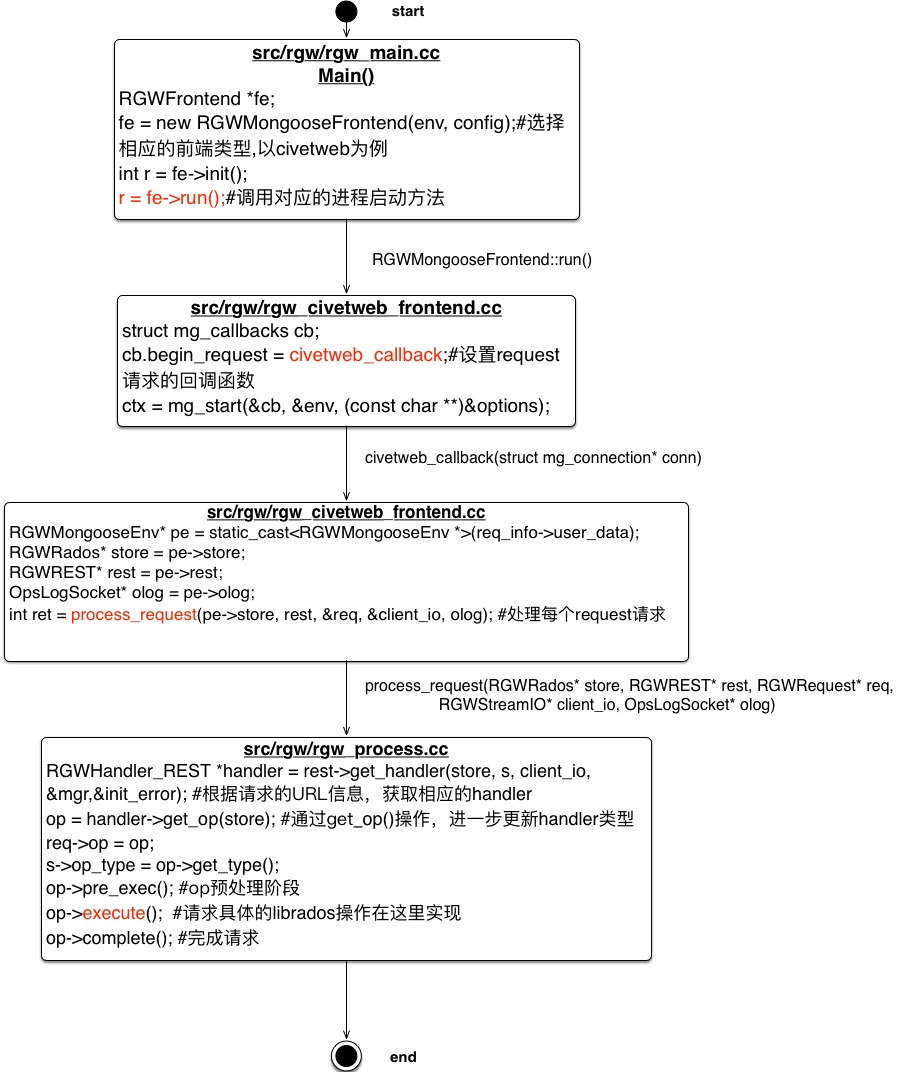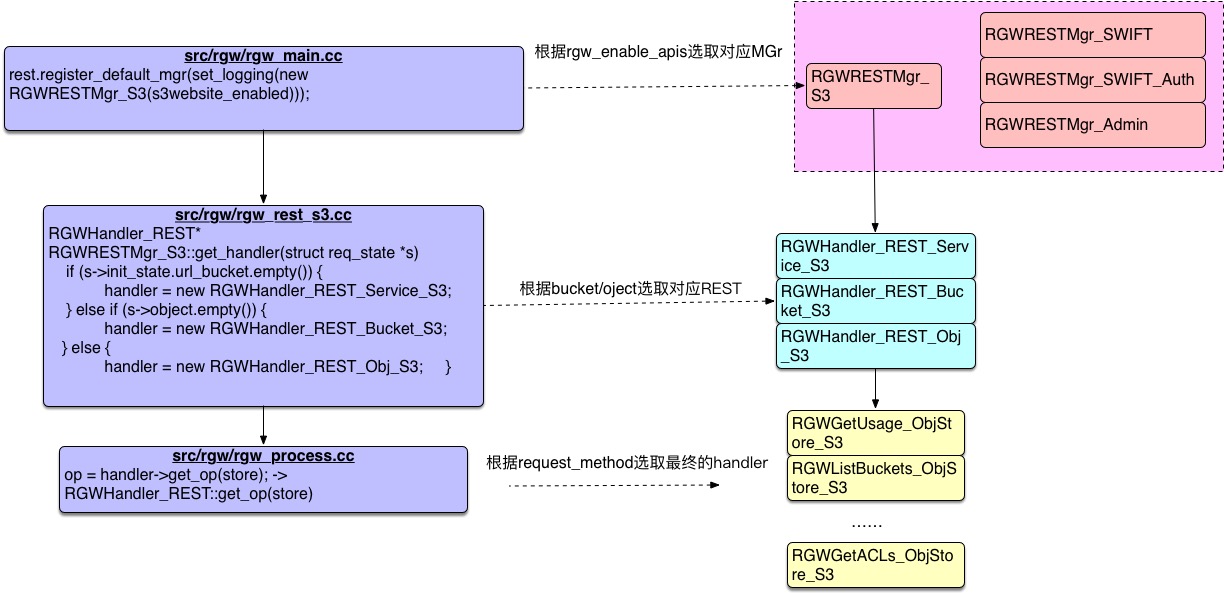您好,登錄后才能下訂單哦!
您好,登錄后才能下訂單哦!
這篇文章主要介紹“怎么理解RGW中request的處理流程”,在日常操作中,相信很多人在怎么理解RGW中request的處理流程問題上存在疑惑,小編查閱了各式資料,整理出簡單好用的操作方法,希望對大家解答”怎么理解RGW中request的處理流程”的疑惑有所幫助!接下來,請跟著小編一起來學習吧!
以civetweb為例

rgw_main.cc為整個radosgw服務的入口,main()函數中根據在ceph.conf的rgw frontends參數設置來選擇不同的前端類型,之后執行相應的run()方法實現整個frontend服務的啟動。注意這里會根據ceph.conf中rgw_enable_apis的設置,實現s3、swift、admin等多種類型的接口生成不同的handler,具體代碼如下
#src/rgw/rgw_main.cc
get_str_list(g_conf->rgw_enable_apis, apis); #獲取接口類型列表
map<string, bool> apis_map;
for (list<string>::iterator li = apis.begin(); li != apis.end(); ++li) {
apis_map[*li] = true;
}
...
if (apis_map.count("s3") > 0 || s3website_enabled) {
if (! swift_at_root) {
rest.register_default_mgr(set_logging(new RGWRESTMgr_S3(s3website_enabled))); #設置S3接口默認handler為RGWRESTMgr_S3
...
if (apis_map.count("swift") > 0) {
do_swift = true;
swift_init(g_ceph_context);
RGWRESTMgr_SWIFT* const swift_resource = new RGWRESTMgr_SWIFT;#設置swift接口默認handler為RGWRESTMgr_SWIFT
...之后在對應的rgw_civetweb_fronted.cc中,根據之前介紹的civetweb啟動流程,設置相應啟動參數,之后使用mg_start()完成civetweb的啟動。(注意參數中callback設置的是civetweb_callback)
#src/rgw/rgw_civetweb_frontend.cc
int RGWMongooseFrontend::run() {
char thread_pool_buf[32];
snprintf(thread_pool_buf, sizeof(thread_pool_buf), "%d",
(int)g_conf->rgw_thread_pool_size);
string port_str;
map<string, string> conf_map = conf->get_config_map();
conf->get_val("port", "80", &port_str);
conf_map.erase("port");
std::replace(port_str.begin(), port_str.end(), '+', ',');
conf_map["listening_ports"] = port_str; #civetweb默認啟動監聽端口
set_conf_default(conf_map, "enable_keep_alive", "yes"); #keep_alive參數設置
set_conf_default(conf_map, "num_threads", thread_pool_buf); #默認threads設置
set_conf_default(conf_map, "decode_url", "no");
...
struct mg_callbacks cb;
memset((void *)&cb, 0, sizeof(cb));
cb.begin_request = civetweb_callback; #回調函數設置
cb.log_message = rgw_civetweb_log_callback;
cb.log_access = rgw_civetweb_log_access_callback;
ctx = mg_start(&cb, &env, (const char **)&options); #啟動服務
if (!ctx) {
return -EIO;
}
return 0;
} /* RGWMongooseFrontend::run */經過上一步的設置,在civetweb_callback中每一個request請求都需要經過process_request()進行處理,注意每個request請求都會綁定一組RGWRados(負責底層Librados的數據讀寫)/RGWREST(對應request和Response的處理)/OpsLogSocket(日志消息記錄)
#src/rgw/rgw_civetweb_frontend.cc
static int civetweb_callback(struct mg_connection* conn) { struct mg_request_info* req_info = mg_get_request_info(conn); RGWMongooseEnv* pe = static_cast<RGWMongooseEnv *>(req_info->user_data);
{ // hold a read lock over access to pe->store for reconfiguration RWLock::RLocker lock(pe->mutex);
RGWRados* store = pe->store; RGWREST* rest = pe->rest; OpsLogSocket* olog = pe->olog;
RGWRequest req(store->get_new_req_id()); RGWMongoose client_io(conn);
int ret = process_request(pe->store, rest, &req, &client_io, olog); #每個request請求綁定一組前面的RGWRados、RGWREST、OpsLogSocket ... ```
之后調用rgw_process.cc中的process_request(),其中rest->get_handler根據請求的URL是否包含bucket、object信息,獲取到對應的handler類型,之后調用handler->get_op(store)根據前面取得的handler對應request_method獲取到最終的handler,之后觸發handler對應的pre_exec()、execute()、complete()完整整個request請求的處理,代碼如下:
#src/rgw/rgw_process.cc
int process_request(RGWRados* store, RGWREST* rest, RGWRequest* req,GWStreamIO* client_io, OpsLogSocket* olog)
{int ret = 0;
client_io->init(g_ceph_context);
...
RGWHandler_REST *handler = rest->get_handler(store, s, client_io, &mgr,&init_error); #這里根據URL里面是否包含bucket、Object字段會進一步獲取到對應的handler類型
if (init_error != 0) {
abort_early(s, NULL, init_error, NULL);
goto done;
}
dout(10) << "handler=" << typeid(*handler).name() << dendl;
should_log = mgr->get_logging();
req->log_format(s, "getting op %d", s->op);
op = handler->get_op(store); #這里根據request_method獲取到最終處理request請求的handler類型
...
req->log(s, "pre-executing");
op->pre_exec(); #請求預處理
req->log(s, "executing");
op->execute(); #具體請求的具體實現
req->log(s, "completing");
op->complete(); #完成請求處理#src/rgw/rgw_process.cc
RGWHandler_REST* RGWRESTMgr_S3::get_handler(struct req_state *s)
{
bool is_s3website = enable_s3website && (s->prot_flags & RGW_REST_WEBSITE);
int ret =
RGWHandler_REST_S3::init_from_header(s,
is_s3website ? RGW_FORMAT_HTML :
RGW_FORMAT_XML, true);
if (ret < 0)
return NULL;
RGWHandler_REST* handler;
// TODO: Make this more readable
if (is_s3website) {
if (s->init_state.url_bucket.empty()) {
handler = new RGWHandler_REST_Service_S3Website;
} else if (s->object.empty()) {
handler = new RGWHandler_REST_Bucket_S3Website;
} else {
handler = new RGWHandler_REST_Obj_S3Website;
}
} else {
if (s->init_state.url_bucket.empty()) {
handler = new RGWHandler_REST_Service_S3; #bucket為空則切換到RGWHandler_REST_Service_S3
} else if (s->object.empty()) {
handler = new RGWHandler_REST_Bucket_S3; #obj為空則切換RGWHandler_REST_Bucket_S3
} else {
handler = new RGWHandler_REST_Obj_S3; #bucket和Object都不為空,則切換到RGWHandler_REST_Obj_S3
}
}
ldout(s->cct, 20) << __func__ << " handler=" << typeid(*handler).name()
<< dendl;
return handler;
}#src/rgw/rgw_rest.cc
RGWOp* RGWHandler_REST::get_op(RGWRados* store)
{
RGWOp *op;
switch (s->op) #這里s對應一個req_state的結構體
{ rest->op
case OP_GET:
op = op_get();
break;
case OP_PUT:
op = op_put();
break;
case OP_DELETE:
op = op_delete();
break;
case OP_HEAD:
op = op_head();
break;
case OP_POST:
op = op_post();
break;
case OP_COPY:
op = op_copy();
break;
case OP_OPTIONS:
op = op_options();
break;
default:
return NULL;
}
if (op) {
op->init(store, s, this);
}
return op;
} /* get_op */結構體定義
struct req_state {
CephContext *cct;
RGWClientIO *cio;
RGWRequest *req; /// XXX: re-remove??
http_op op; #對應一個枚舉類型,具體如下
RGWOpType op_type;
...
enum http_op {
OP_GET,
OP_PUT,
OP_DELETE,
OP_HEAD,
OP_POST,
OP_COPY,
OP_OPTIONS,
OP_UNKNOWN,
};理解整個URL轉換handler的過程,能夠感覺request信息快速定位具體的op操作,方便debug,整個過程用下面一張圖總結。

到此,關于“怎么理解RGW中request的處理流程”的學習就結束了,希望能夠解決大家的疑惑。理論與實踐的搭配能更好的幫助大家學習,快去試試吧!若想繼續學習更多相關知識,請繼續關注億速云網站,小編會繼續努力為大家帶來更多實用的文章!
免責聲明:本站發布的內容(圖片、視頻和文字)以原創、轉載和分享為主,文章觀點不代表本網站立場,如果涉及侵權請聯系站長郵箱:is@yisu.com進行舉報,并提供相關證據,一經查實,將立刻刪除涉嫌侵權內容。